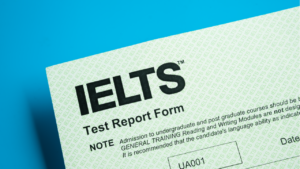The International English Language Testing System (IELTS) is widely recognised as one of the most popular and respected English language proficiency tests worldwide. Over 10,000 organisations accept it in more than 140 countries like the USA, UK, Canada, Australia and many more.
Every year, over three million people take the IELTS exam, which is growing steadily. It comprises 4 sections-
The IELTS Speaking Test is particularly significant and challenging for a few candidates. It consists of 3 Parts: Introduction and Interview, Cue Card Round, and Long Discussion.
As an IELTS aspirant, one of the tasks you will encounter during your IELTS Speaking Test is the cue card section. These topics test your ability to describe things and your communication skills. The key is providing a clear, detailed answer while engaging your audience.
To better understand the IELTS Speaking test, look at “Describe a crowded place you have visited” and learn ways to present this section in the best way possible.
Leap Advantage Virtual Spot Offer Event on May 10th 2024

Last call to secure your spot for Masters in US for Fall ’24 Intake
Leap Advantage Virtual Spot Offer Event on May 10th 2024
Last call to secure your spot for Masters in US for Fall ’24 Intake

IELTS Speaking Test
IELTS is a standardised test that measures your English proficiency. Among the 4 modules, the Speaking section is the most interactive and personal.
The Speaking Test is 11 to 14 minutes long. It consists of three parts, each designed to evaluate different aspects of your speaking skills.
The Three speaking sections are:
| Part 1– Introduction and Interview: The examiner will ask general questions about your family, work, study, likes, dislikes and more. Part 2– Cue Card Segment: In this part, you must speak on a given topic for two minutes. You will have one minute to prepare your response. Part 3– Long Discussion: The examiner will ask you follow-up questions related to the topic discussed in Part 2 |
Let us understand the IELTS Speaking Part 2: Cue Card Section.
IELTS Speaking Part 2: Cue Card
Part 2 of the IELTS Speaking Test is the Cue Card or the Talk section. The Cue Card is a crucial part of the IELTS Speaking exam, usually in the middle of the exam.
It tests your ability to speak fluently on a topic and organise your thoughts effectively. The Cue Card round is allotted 3-4 minutes of speaking time, and the examiner will give you a Cue Card with a topic.
Total Duration of IELTS Speaking Part 2
| Duration of IELTS Speaking Part 2 | 3-4 minutes |
| Preparation Time | 1 minute |
| Speaking Time | 2-3 minutes |
You will have one minute to prepare your notes and two minutes to speak on the topic. Use your preparation time wisely and jot down key points you want to cover in your speech. You can use abbreviations or short forms to save time, but ensure you can understand them later.
When you are done speaking for the two minutes are up, the examiner will ask you one or two follow-up questions about the topic. This is your chance to showcase your ability to express your perspectives and ideas in more detail and to provide examples and details to support them.
Crack IELTS Exam in first attempt

Attend Leap’s free masterclass to get tips, tricks and advance strategies to crack IELTS exam in first attempt
Crack IELTS Exam in first attempt
Attend Leap’s free masterclass to get tips, tricks and advance strategies to crack IELTS exam in first attempt

How to Answer the Cue Card: Describe A Crowded Place You Have Visited
After getting the Cue Card, you must prepare your answer next.
You can start by breaking down your answer into small parts to help you answer the question better. Let us understand it with the help of our topic: Describe a crowded place you have visited.
- Name the crowded place you have visited.
- Describe the crowd and your experience.
- Describe the different sections of the crowded place and what you have seen there.
- How would you recommend this place to others?
You can answer the questions one by one. Define each point clearly and concisely, considering the time limit provided.
Sample Answer 1: Describe A Crowded Place You Have Visited
Now, look at a few sample answers. You can refer to them to structure your answers, grammatical style, tone, and the vocabulary used in each of them.
Here is the sample answer 1 to Describe a Crowded Place You Have Visited. Refer to it appropriately for better understanding.
Introduction
I visited Turkey in 2019, where I experienced one of Istanbul’s most popular and crowded markets.
What is the name of the crowded place you have visited?
- The crowded place I visited was the Grand Bazaar. It is situated in the city’s heart and regularly attracts crowds.
- The Grand Bazaar is one of the world’s oldest and largest covered markets, with over 4,000 shops selling jewellery, textiles, carpets, spices, and souvenirs.
Describe the crowd and your experience.
- I got overwhelmed by the sounds, smells, and colours when I entered the market. The market was full of different activities, and people were moving everywhere.
- The narrow alleys were filled with people, and it was pretty tricky to navigate through the crowds.
- One of the most memorable parts of my visit was the spice market. The aroma of spices filled the air, and the colours of the various spices were terrific. Also, the vendors were very cordial and knowledgeable.
How would you recommend this place to others?
I recommend this place to the visitors. This place has a lot to offer with its exclusive shops and architecture.
Conclusion
Overall, the experience was memorable, and I would love to go there again. Moreover, I spiked interest in the history and architecture of the place.
Sample Answer 2: Describe A Crowded Place You Have Visited
Look at sample answer 2 as follows. Analyse-it properly to curate the best possible answer.
Introduction
I have been a fan of New York City since I was a kid, and my best experience of visiting a crowded place was in New York only.
What is the name of the crowded place you have visited?
The crowded place that I visited was Times Square in New York City. Times Square is famous for its lights, bustling crowds, and towering billboards.
Describe the crowd and your experience.
- When I came out of my cab at Times Square, I was blown as the city looked so sparkly and beautiful at night.
- The crowd was overwhelming, and walking without bumping into someone was difficult. The noise level was also incredibly high, with honking cars, street performers, and music blasting from every direction.
- Despite the chaos, I found Times Square to be an exciting and vibrant place. It is one of the places you will never be able to experience elsewhere. The aura of the place was so incredible.
How would you recommend this place to others?
Times Square is a must-visit destination for anyone travelling to New York City.
Conclusion
Although it can be overwhelming at first, the energy and excitement of the crowds were truly infectious.
IELTS Speaking Part 3: Discussion
The third part of the IELTS Speaking Test is the Long Discussion. It lasts about 4-5 minutes and is based on abstract questions about the topic from Part 2.
The way to answer them is to be on point and concise. However, don’t speak slowly and too little. Try to add relevant supporting information to complete your answer.
Go through these follow-up questions thoroughly to understand how to answer them effectively.
1. Why do people visit crowded places?
A. The crowded places have a unique energy that attracts people. Many people visit crowded places for socialising, others for cultural or entertainment events. Many people visit crowded places for shopping or dining. Moreover, some people enjoy the hustle and bustle of crowded places, while others find it overwhelming.
2. How do governments manage crowd control in public spaces?
A. Governments employ various methods to manage crowd control in public spaces. For instance, they may use barriers, security personnel, and surveillance cameras to monitor crowds. Sometimes, there is a restriction on the number of people Additionally, governments can use public announcements and social media to inform people about the crowd situation and provide alternative routes or locations.
3. How do people behave differently in crowded places than in empty ones?
A. People behave differently in crowded places than in empty ones. People tend to move faster, speak louder, and compete more in crowded places. They may also feel more stressed and anxious due to the noise and congestion. In contrast, in empty places, people tend to be more relaxed, quieter, and slower.
4. What are the advantages and disadvantages of visiting crowded places?
A. There are both advantages and disadvantages to visiting crowded places. On one hand, they offer a unique experience of excitement, energy and social interaction. They provide us with entertainment opportunities. On the other hand, crowded places can be overwhelming, stressful, and dangerous. They may also be prone to theft, pickpocketing, and scamming.
5. Do you think technology can help decrease overcrowding in public spaces?
A. Technology has the potential to decrease overcrowding in public spaces. For example, governments can use real-time crowd monitoring and prediction software to anticipate and manage crowds. They can also use location-based services to direct people to less crowded areas or provide virtual experiences of crowded places. However, technology can create new problems like privacy violations and data breaches.
Tips to Answer the IELTS Cue Card
If you prepare correctly, scoring on the IELTS Speaking Test is simple. So, let’s look at some tips you can follow while answering the IELTS Cue Card to secure a higher band.
Understand the task: Before answering the IELTS Cue Card, you must understand the task. You must read the topic carefully and ensure you understand the question.
Plan your answer: The preparation time should be wisely used to plan and organise your answer before speaking.
Use relevant examples: Make use of relevant examples, as this will make your answer interesting and engaging.
Speak clearly: Maintain a moderate pace and speak clearly. Take enough time while answering.
Use appropriate vocabulary: Use appropriate vocabulary to express your ideas. This will help to show your range of vocabulary and improve your score.
Be confident: Be confident while speaking, as this will help you to convey your ideas to the examiner.
Avoid repetition: Try to include a variety of words in your sentence structure and avoid repetition.
Following these tips can improve your performance and help you aim to score a higher band. Remember to practice regularly and constantly check on your performance.
Need more help? Sign up for our IELTS Masterclass and get access to expert training, mock tests, IELTS resources, speaking evaluations and more!
Also Read:
Describe A Cafe You Like To Visit
Describe a Long Car Journey You Went on
Describe a Time When You Observed the Stars
Describe a Difficult Thing You Did
Describe a chocolate you didn’t like
Frequently Asked Questions
-
Q. What questions are asked on the IELTS Cue Card for something?
A. The IELTS test is designed to assess proficiency in individuals who wish to study or work in English-speaking countries.
The types of questions one can get in the speaking section are:
“Describe a place you would like to visit”
“Talk about a hobby or activity you enjoy”
“Describe an achievement you are proud of“
“Describe a Crowded Place You Have Visited“ -
Q. Do IELTS Cue Card topics repeat?
A. There are rare chances of this happening. The IELTS Cue Cards are updated every 4-months, and almost 50% of the topics are changed. This happens in April, September, and December.
-
Q. What is the time limit for speaking on the Cue Card?
A. In the IELTS Cue Card test, you must continuously speak for 2 minutes until the examiner asks you to stop. The IELTS speaking part 2 lasts about 3 minutes, including the 1-minute preparation time. You must practice and prepare Cue Card topics well to avoid score deduction.
-
Q. How can I improve speaking for the Cue Card?
A. You can improve your cue card by practising and preparing for the cue card section. Take the help of a friend and practice speaking with them. You can also speak in front of the mirror. Keep practising a range of topics to improve fluency and vocabulary.
-
Q. How will I be scored in the IELTS speaking section?
A. The IELTS Speaking Test assesses your ability to communicate in English. Your performance will be scored in a band of 0 to 9. The examiner awards band scores for your speech—English language skills. The Speaking Test will take place in a face-to-face interview with a qualified IELTS examiner in a quiet room.
-
Q. What is the speaking cue card format?
A. In IELTS Speaking Part 2, you will be handed a cue card that contains a prompt and three to four bullet points. The prompt is the topic on which you have to speak. The three bullet points are the sub-questions, and the supplementary is a follow-up question.
-
Q. How can I practice for the IELTS cue card?
A. A few tips that you can follow to excel in your IELTS cue card are
1. Practice using practice cue card questions. You will easily find them on the internet.
2. Use 1-minute preparation time wisely.
3. Record yourself while speaking for 2 minutes.
4. Stay calm and confident.
5. Use a wide range of vocabulary. -
Q. Is the IELTS Speaking Test the same for Academic and General Training?
A. The IELTS Exam is the same for both Academic and general. The main difference between the exams is in the Writing and Reading sections. The IELTS Speaking Test is a brief assessment that evaluates your proficiency in English, comprehension skills, and ability to express your thoughts and viewpoints. It is a one-on-one interview with the examiner and takes about 11-14 minutes. You will be scored ranging from 0 to 9 based on your performance.
-
Q. Can I ask the examiner to repeat a question in the IELTS Speaking Test?
A. Yes. If you don’t understand the question, you can prompt the examiner to repeat the question. You should seek clarity in the question if you are confused. If you don’t, you might sound irrelevant. You get 2 minutes of preparation time for the cue cards, so take that time to come up with an answer.
-
Q. Can I use informal language in the IELTS Speaking Test?
A. Using informal language in the IELTS Speaking Test is generally not recommended. The test assesses your ability to use English in academic settings; formal language is more appropriate. Overusing informal language can negatively impact your score as it may indicate a lack of language proficiency. Using formal language and avoiding slang is essential to achieve a higher score.
-
Q. How long does it take to receive IELTS Speaking results?
A. The results for the IELTS Speaking test are usually released within 5-13 days. The Test Report Form (TRF) includes your scores for each module, including Speaking. After taking the IELTS Speaking Test, you can expect to receive your results within 5-13 days. The Test Report Form (TRF) will include your scores for each module, including Speaking. The TRF will also include your overall band score, an average of your scores across all four modules. The band score ranges from 0-9, each representing a level of English proficiency.







